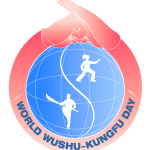WWKD is celebrated each year on the first Saturday on or following August 8th. The details for the debut of WWKD in 2018 are as follows:
- When: Saturday August 11th 2018
- Theme: Kung Fu in Everyday Life
- Where: Everywhere
- Who can participate: Everyone
Logo Introduction
 IWUF specially designed the following logo to commemorate the first World Wushu Kung Fu Day, with the classic read and blue colours of the IWUF. The logo centre is the earth, representing the global celebration of wushu enthusiasts, and the is encompassed by and iconic wushu gesture, paying tribute to martial artists all over the world. The earth is bisected by a curved line, calling to mind the traditional concepts of yin and yang (balance), and is accompanied by two vivid silhouettes of Chunqiu halberd (Chunqiu dadao) and tai chi practitioners. The holiday’s name “World Wushu Kung Fu Day” is inscribed on the scrolls around the earth book-ended by a wushu sword and knife.
IWUF specially designed the following logo to commemorate the first World Wushu Kung Fu Day, with the classic read and blue colours of the IWUF. The logo centre is the earth, representing the global celebration of wushu enthusiasts, and the is encompassed by and iconic wushu gesture, paying tribute to martial artists all over the world. The earth is bisected by a curved line, calling to mind the traditional concepts of yin and yang (balance), and is accompanied by two vivid silhouettes of Chunqiu halberd (Chunqiu dadao) and tai chi practitioners. The holiday’s name “World Wushu Kung Fu Day” is inscribed on the scrolls around the earth book-ended by a wushu sword and knife.
Why have a World Wushu Kung Fu Day?
There are so many benefits to kung fu practice. Its exciting. It boosts confidence. It promotes health. Its fun. But most of all, it makes you feel so good!
This got IWUF thinking…
What if we had a World Wushu Kung Fu Day to celebrate what we do? So at the last World Wushu Championships in Kazan, Russia, the IWUF Congress decided to designate August 11, 2018 as the first ever World Wushu Kung Fu Day.
What we need you to do is let IWUF know how you kung fu!
So How Can I Participate?
- Demonstrations: Make kung fu really visible. Get everyone involved!
- Contribute Content: Be creative. Become a face of kung fu.
- Before World Wushu Kung Fu Day: Share with the world what kung fu is like where you live.
- Send a photo of at least 300 ppi that shows how you include kung fu in your life.
- Make a video that shows your community and what kung fu is like there. Videos should be HD 1280 x 720 (720 p).
- Write an essay of 250-650 words that describes what kung fu means to you. How and why did you start? Why do you keep at it? Why is it important to you?
- Send your entry by July 31, 2018 to media@iwuf.org
And When World Wushu Kung Fu Day is Over, Let Us Know How You Celebrated!
When this first ever World Wushu Kung Fu Day is over, send us a video to show how you celebrated.
- Did you host a workshop?
- Did you have a performance?
Send your entry by Saturday August 18th, 2018 to media@iwuf.org. And keep an eye on the IWUF website. You just might find your celebration featured there.
Logo download:
http://www.iwuf.org/upload/2018/0706/885c95b1fffdb7f8ec8b81042b327f7081f003bb.pdf
Brochure download:
http://www.iwuf.org/upload/2018/0726/7b013fc47c80d1511ef26042f624efa0ee5662aa.pdf
Keep up with all the events of WWKD by following IWUF on social media at:
- https://www.facebook.com/iwufofficial
- https://www.facebook.com/groups/iwufwushu/about/
- https://www.twitter.com/iwufofficial
- https://www.youtube.com/user/iwufwushu
- https://www.weibo.com/iwuf
- https://www.instagram.com/iwuf_official/
Taolu
Taolu refers to the set routine (form) of wushu. Taolu routines comprise of a continuously connected set of predetermined techniques, choreographed to that incorporate movements and stylistic principles of attack and defence. These include hand and leg techniques, jumps, sweeps, stances and footwork, seizing, throwing, wrestling, and balances.
Main Taolu Competition Events:
- Changquan
- Nanquan
- Taijiquan
- Shuangjian
- Baguazhang
- Taijijian
- Daoshu
- Gunshu
- Qiangshu
- Jianshu
- Shuangdao
- Duilian
- Nangun
- Nandao
- Xingyiquan
Sanda
Sanda is a modern unarmed combat sport that developed from traditional wushu styles, and primarily makes use of punching, kicking, throwing, wrestling, and defensive techniques.
Sanda competition includes 11 weight categories for men and 7 weight categories for women.
Men’s categories: 48kg, 52kg, 56kg, 60kg, 65kg, 70kg, 75kg, 80kg, 85kg, 90kg, 90kg+
Women’s categories: 48kg, 52kg, 56kg, 60kg, 65kg, 70kg, 75kg
Traditional Kung Fu
Traditional kung fu is the root of competitive wushu and has a long and diverse history. Originating thousands of years ago in China, different kung fu styles featuring various methods, philosophies, tactics and techniques emerged over time. Traditional kung fu’s practice aims to preserve the legacies of previous generations that relied on these arts for survival and life improvement.
A wide variety of styles and practices can be found, some featuring mainly hand techniques, others focusing on leg techniques, while other feature wrestling; some focus on attack and defence while yet other strive to promote and preserve health and well-being. Traditional kung fu also includes a vast array of weaponry handed down from the age of cold weapons, with methods preserved by subsequent generation. With numerous clans, secs family systems and styles, traditional kung fu is practiced b people from all walks of life, irrespective of race, gender age, social class or physical condition. Kung fu is a cultural and sporting gem of all people.